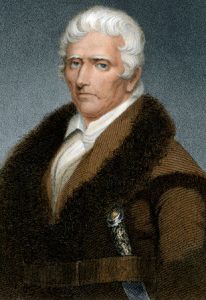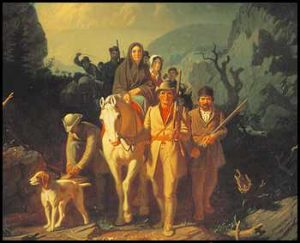 I grew up in a time when western shows were all the rage on television. One show that my family always watched was Daniel Boone. Most people know Daniel Boone from their history classes, as an American frontiersman. Most of his fame stemmed from his exploits during the exploration and settlement of Kentucky. Boone arrived in Kentucky in 1767, about 25 years before it became a state on June 1, 1792. He spent the next 30 years exploring and settling the lands of Kentucky, including carving out the Wilderness Road and building the settlement station of Boonesboro. Without Boone the history of Kentucky would have been much different.
I grew up in a time when western shows were all the rage on television. One show that my family always watched was Daniel Boone. Most people know Daniel Boone from their history classes, as an American frontiersman. Most of his fame stemmed from his exploits during the exploration and settlement of Kentucky. Boone arrived in Kentucky in 1767, about 25 years before it became a state on June 1, 1792. He spent the next 30 years exploring and settling the lands of Kentucky, including carving out the Wilderness Road and building the settlement station of Boonesboro. Without Boone the history of Kentucky would have been much different.
Boone was born near Reading, in Berks County, Pennsylvania, the son of hard-working but adventurous Quaker parents. He learned some blacksmithing, but had very little formal education. Daniel appears to have been a scrappy lad who loved hunting, the wilderness, and independence. When his parents left Pennsylvania in 1750 bound for the Yadkin valley of northwest North Carolina, Daniel went along willingly, because the move fit right in with his spirit of adventure.
Upon arriving in North Carolina, the cutting edge of the frontier, he was able to indulge his hunting prowess and love of the wilderness. In the years that followed, he served as a wagoner with General Edward Braddock’s ill-fated expedition to Fort Duquesne in 1755. Boone then married a neighbor’s daughter, Rebecca Bryan, in 1756, and in 1758 is believed to have been a wagoner with General John Forbes who was hacking out the road to Fort Duquesne, which he rebuilt as Fort Pitt…now Pittsburgh. Back in North Carolina, Daniel purchased land from his father but never seriously engaged in farming. He loved to roam far too much to settle down and farm the land in one place. In 1763 he and his brother Squire journeyed to Florida, but for unknown reasons they did not stay. I guess Kentucky would always be his first love.
Boone was first in eastern Kentucky in 1767, but his expedition of 1769-1771 is more widely known. With a small party Boone advanced along the Warrior’s Path into a beautiful garden-like region. When the time came for the party to return he remained behind in the wilderness until March 1771. On the way home, he and his brother were robbed by Indians of their deer skins and pelts, but the two remained exuberant over the land known as “Kentuck.”
So much did Daniel love that “dark and bloody ground” that he tried to return in 1773, taking forty settlers with him, but the Indians drove them back. The next year he went again into the region carrying a warning of Indian troubles to Governor John Murray Dunmore’s surveyors. As Judge Richard Henderson was concluding the Treaty of Sycamore Shoals. in March 1775, by which much of Kentucky was sold to his Transylvania Company, Boone was hacking out the Wilderness Road. As soon as he reached his destination, he began building Boonesboro, one of several stations, or forts under construction at that time. For the next four years…through 1778…Boone was a captain in the militia, and was busy defending the settlements. His leadership  helped save the three remaining Kentucky stations, Boonesboro, Logan’s (St. Asaph’s), and Harrodsburg. These were years of many ambushes; such as Blue Licks in 1778; captures, including Boone, himself, who was was captured but escaped from the Shawnees; rescues, and desperate defenses.
helped save the three remaining Kentucky stations, Boonesboro, Logan’s (St. Asaph’s), and Harrodsburg. These were years of many ambushes; such as Blue Licks in 1778; captures, including Boone, himself, who was was captured but escaped from the Shawnees; rescues, and desperate defenses.
I knew and have learned much about Daniel Boone over the years, but for me the most interesting thing I have learned is that Daniel Boone is my 5th Cousin 8 times removed, on the Pattan side of my mother, Collene Spencer’s family. It is a small, small world. Today is Daniel Boone Day. It is a day to remember all this great man did for our country.


Leave a Reply